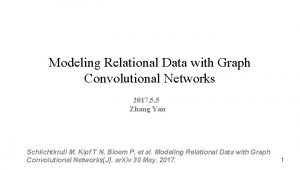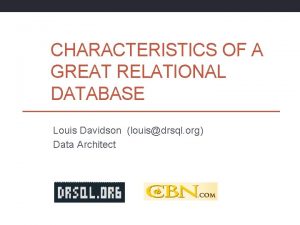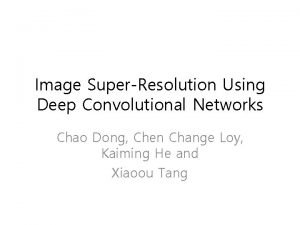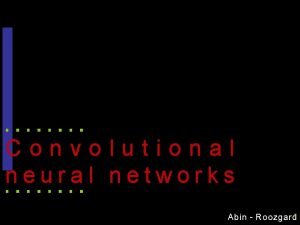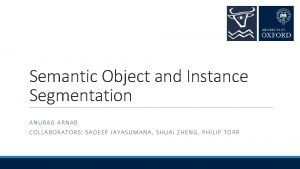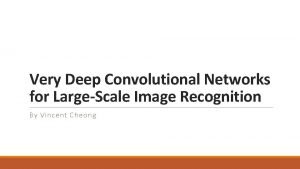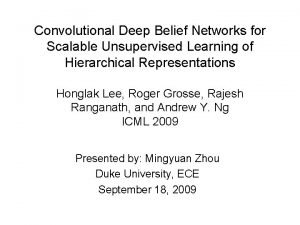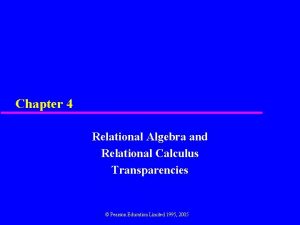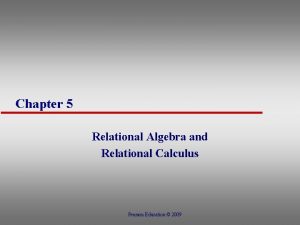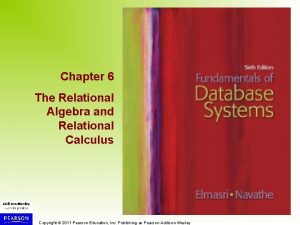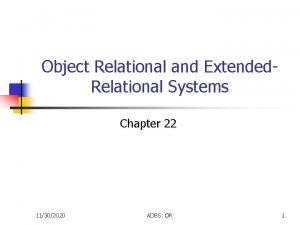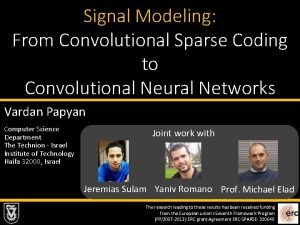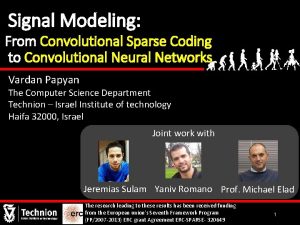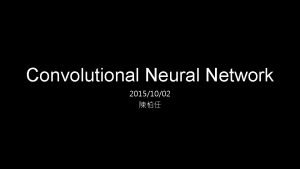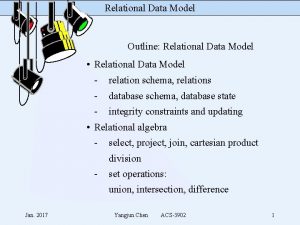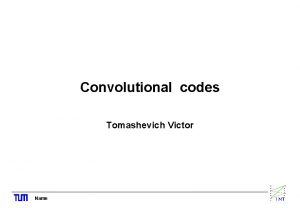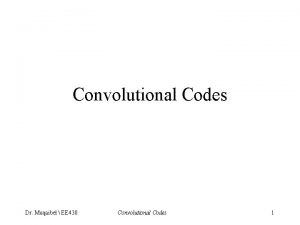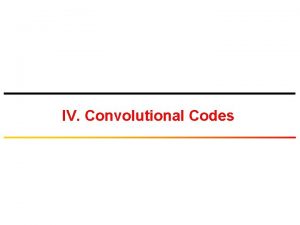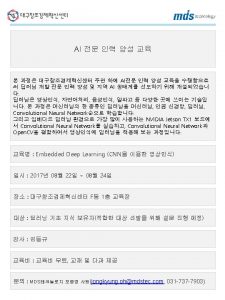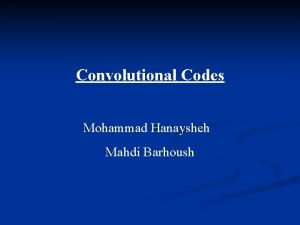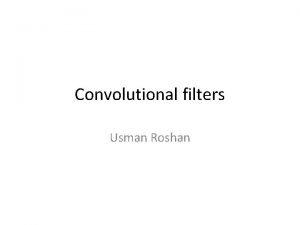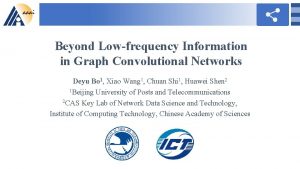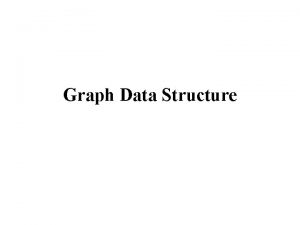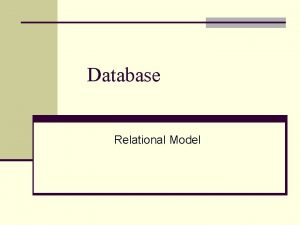Modeling Relational Data with Graph Convolutional Networks 2017










![Link Prediction • Dataset [Bordes, NIPS’ 13] Link Prediction • Dataset [Bordes, NIPS’ 13]](https://slidetodoc.com/presentation_image_h2/78ae1fe880849a159bee5f0a8cf34a6b/image-11.jpg)








- Slides: 19

Modeling Relational Data with Graph Convolutional Networks 2017. 5. 5 Zhang Yan Schlichtkrull M, Kipf T N, Bloem P, et al. Modeling Relational Data with Graph Convolutional Networks[J]. ar. Xiv 30 May, 2017. 1

Knowledge Graph Completion Task • Link Prediction(recovery of missing facts, subject-predict-object triples) • Entity Classification(recovery of missing attributes of entities) Intuition

Relational Graph Convolutional Networks

Relational Graph Convolutional Networks In each R-GCN layer, hidden state info is propagated across edges of graph, taking into account the relation and direction of an edge. A single layer takes the following form

Relational Graph Convolutional Networks In each R-GCN layer, hidden state info is propagated across edges of graph, taking into account the relation and direction of an edge. A single layer takes the following form:

Relational Graph Convolutional Networks In each R-GCN layer, hidden state info is propagated across edges of graph, taking into account the relation and direction of an edge. A single layer takes the following form

Relational Graph Convolutional Networks In each R-GCN layer, hidden state info is propagated across edges of graph, taking into account the relation and direction of an edge. A single layer takes the following form

Relational Graph Convolutional Networks

Relational Graph Convolutional Networks

Tasks The model is applied to two tasks: Link Prediction - Generates a response y given dialogue history x. Standard Seq 2 Seq model with Attention Mechanism Entity Classification - - Binary Classifier that takes as input a sequence of dialogue utterances {x, y} and outputs label indicating whether the input is generated by human or machines Hierarchical Encoder + 2 class softmax function -> returns probability of the input dialogue episode being a machine or human generated dialogues.
![Link Prediction Dataset Bordes NIPS 13 Link Prediction • Dataset [Bordes, NIPS’ 13]](https://slidetodoc.com/presentation_image_h2/78ae1fe880849a159bee5f0a8cf34a6b/image-11.jpg)
Link Prediction • Dataset [Bordes, NIPS’ 13]

Link Prediction Encoder: an R-GCN producing latent feature representation of entities Decoder: a tensor factorization model exploiting these representation to predict labeled edges. (Dis. Mult) [Bishan et al. , ICLR ‘ 15] Training: use cross-entropy loss to push the model to score observable triples higher than the negative ones(negative sampling):

Experiment • Result

Experiment • Result

Entity Classification • Dataset

Entity Classification The task is to classify the properties of a group of entities represented as nodes. (semisupervised node classification) Training: use cross-entropy loss on all labeled nodes(ignoring unlabeled nodes):

Experiment • Result : performs better than pervious methods on the AIFB dataset, but worse on the two other datasets. (specific choice of normalization in the model, which makes R-GCNs invariant to the node degree-thereby making the model insensitive to a potentially essential feature for some datasets )

Notes • Integrate entity features in R-GCNs, which would be beneficial both for link prediction and entity classification • Path features may be considered in R-GCNs for link prediction task. • Gain a better understanding of how basis transformations are used to represent knowledge base relations, it would be interesting to perform a more thorough analysis of learned relation embeddings.

GCN model architecture
 Modeling relational data with graph convolutional networks
Modeling relational data with graph convolutional networks Relational modeling vs dimensional modeling
Relational modeling vs dimensional modeling Louis davidson relational data modeling
Louis davidson relational data modeling Visualizing and understanding convolutional neural networks
Visualizing and understanding convolutional neural networks Convolutional neural networks for visual recognition
Convolutional neural networks for visual recognition Style transfer
Style transfer Convolutional neural network presentation
Convolutional neural network presentation Image super resolution using deep convolutional networks
Image super resolution using deep convolutional networks Csrmm
Csrmm Xooutput
Xooutput Lmu cis
Lmu cis Convolutional neural networks
Convolutional neural networks Instance segmentation
Instance segmentation Deep convolutional networks
Deep convolutional networks Convolutional deep belief networks
Convolutional deep belief networks Alternatives to convolutional neural networks
Alternatives to convolutional neural networks The limited tuple relational calculus equals:
The limited tuple relational calculus equals: Relational algebra to tuple relational calculus
Relational algebra to tuple relational calculus Relational algebra aggregate functions examples
Relational algebra aggregate functions examples Object relational and extended relational databases
Object relational and extended relational databases
